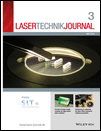When Ideas Serve as Benchmark
The rapid ascent of low coherence interferometry in laser materials processing
Abstract
Following the specialized press in the last five years the rise of low coherence interferometry as the prime sensor technology for quality assurance, quality control and even real-time process control in nearly all laser materials processing areas is more than remarkable. The initial idea to use this technology for just measuring the depth of the keyhole in high power laser welding was soon extended, when Precitec introduced the sensor device to laser materials processing experts which helped to exploit the full potential in many other areas than just laser welding.
At present the Precitec IDM — in-process depth meter — is the preferred sensor when it comes to measure continuous wave, short pulsed, or even ultra short pulsed laser process ing, independent of the processed material. It is the ideal sensor technology when it comes to accurately acquire 3D topography information around the interaction zone itself, allowing for integration of pre- and post-process features in the system software.




